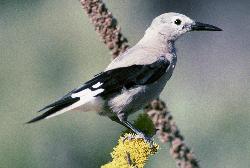
Clark’s Nutcracker
Nucifraga columbiana
Courtesy US FWS
Dave Menke, Photographer

Red Squirrel
Tamiasciurus hudsonicus
Courtesy US FWS
Donna Dewhurst, Photographer
Hi, this is Mark Larese-Casanova from the Utah Master Naturalist Program at Utah State University Extension.
Throughout Utah’s forests, many plants and animals take advantage of other organisms to survive. Whether it is a caterpillar eating a tree leaf, mistletoe growing on a juniper branch, or an owl catching a mouse to eat, one organism being consumed by another is almost inevitable. However, some organisms may inadvertently help others not only survive, but also increase their range.
Many conifer trees, including pines, spruces, and firs, depend on fungi that live in and around their roots. The fine fibers of the fungi act as root hairs, helping trees better absorb water and nutrients from the soil. Some fungi also have symbiotic relationships with bacteria that are able to take Nitrogen from the air and turn it into ammonia, which is one of the forms of nitrogen that helps plants grow. Conifer trees reproduce via seeds from their cones, and fungi produce mushrooms to release spores. Squirrels happen to find conifer seeds and mushrooms particularly tasty, and will readily eat them. As squirrels are known to do, extra food is cached away for winter, and some seeds and mushrooms are inevitably forgotten. This helps disperse seeds and spores, aiding in population growth. So, the fungus helps the tree grow, the tree and fungus provide food for the squirrel, and the squirrel helps the tree and fungus spread to new areas.
The Clark’s nutcracker, a bird closely related to the crow and raven, is also particularly important in aiding in the spread of pine trees. Living at higher elevations, nutcrackers must store food for the long winters on Utah’s mountains. A nutcracker’s stout beak is used to crack open pine cones to retrieve the seeds inside. It stores seeds in a pouch under its tongue, and flies away to cache the seeds for winter. Each Clark’s nutcracker stores tens of thousands of seeds every year. While many seed caches are found and eaten, some are forgotten and germinate into young saplings.
So, while squirrels and nutcrackers are ultimately just looking for a good meal, both play a crucial role in establishing and maintaining healthy forest ecosystems in Utah’s mountains. For Wild About Utah, I’m Mark Larese-Casanova.
For Wild About Utah, I’m Mark Larese-Casanova.
Credits:
Images: Courtesy US FWS images.fws.gov
Text: Mark Larese-Casanova, Utah Master Naturalist Program
at Utah State University Extension.
Additional Reading:
Cornell Lab of Ornithology. Clark’s nutcracker. https://www.allaboutbirds.org/guide/Clarks_Nutcracker/id
Larese-Casanova, M. Utah Master Naturalist Mountains Wildlife Field Guide. Utah State University Extension. 2012.
Maser, C., and Z. Maser. 1988. Interactions among squirrels, micorrhizal fungi, and coniferous forests in Oregon. The Great Basin Naturalist 48(3):358-369.
US Forest Service. Clark’s Nutcracker. https://www.fs.fed.us/database/feis/animals/bird/nuco/all.html#FOOD%20HABITS
Washington Department of Fish and Wildlife. Living with Wildlife: tree squirrels. https://wdfw.wa.gov/living/tree_squirrels.html
